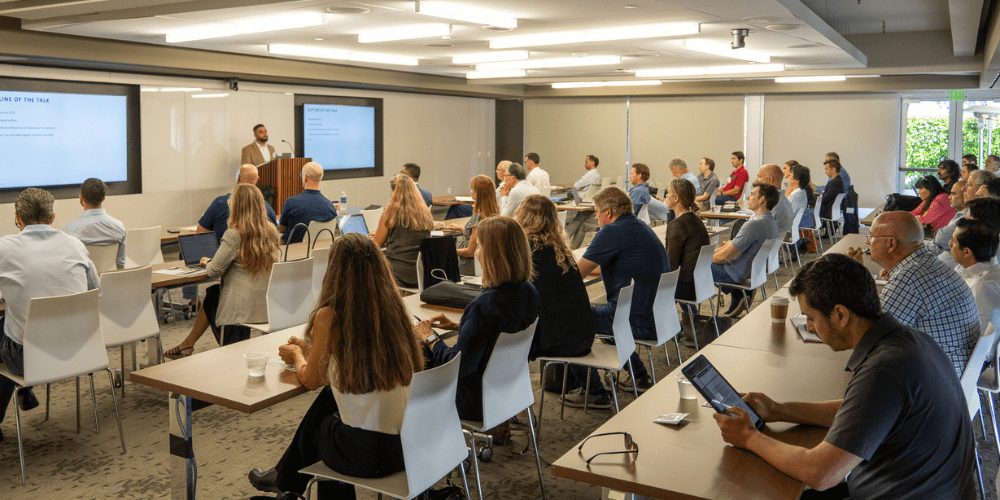
August 28, 2025
NCI SBIR Spotlights Pathways to $6.7M in Cancer Technology Funding

This August, Biocom California welcomed National Cancer Institute (NCI) SBIR Program Directors William Bozza and Swamy Tripurani for an in-depth conversation on federal funding opportunities that support the translation of cancer technologies from the lab to the market. The session provided researchers and entrepreneurs with a comprehensive overview of how to access non-dilutive funding, key application tips, commercialization resources, and success stories that demonstrate the transformative impact of these programs.
Overview of SBIR/STTR Programs
The Small Business Innovation Research (SBIR) and Small Business Technology Transfer (STTR) programs are designed to provide seed funding for early-stage companies advancing innovative cancer-related technologies. Together, these initiatives represented a combined $196 million of NCI’s FY24 extramural R&D budget—$172 million through SBIR and $24 million through STTR. Both offer non-repayable, non-dilutive funding while allowing companies to retain intellectual property rights, gain recognition through NIH peer review, and access a suite of commercialization resources.
Eligibility is open to U.S.-based small businesses with 500 or fewer employees. SBIR permits venture capital ownership, while STTR requires collaboration with a non-profit research institution.
Funding Pathways
Participants learned about the phased funding structure that allows companies to grow their technology from concept to commercialization. Phase I offers $300K–$400K for proof-of-concept studies over one year. Phase II provides up to $2.25 million for two years of R&D. For companies positioned to advance toward commercialization, the Phase IIB Bridge Award offers $4.5 million over 2–3 years to bridge the critical funding gap. Flexible pathways such as Fast Track and Direct-to-Phase II also exist for applicants ready to accelerate development.
Application Guidance
One of the most valuable portions of the discussion centered on practical tips for preparing a competitive application. Program directors emphasized the importance of starting early and sending draft specific aims to a program director at least one month before the deadline. Applicants were encouraged to refine their product vision, draft a strong aims page that clearly identifies the unmet clinical need, current standard of care, the proposed solution, and its advantages, while also tying each goal to product development milestones, key assays, and quantitative analyses.
Administrative registrations—including SAM, Grants.gov, eRA Commons, and SBA Company Registry—must be completed in advance. Applicants were also advised to review similar, currently funded projects in NIH RePORTER, watch PLAN (Peer Learning and Networking) videos on topics like writing a strong aims page, and carefully read funding solicitations to ensure compliance with requirements.
Commercialization and Non-Funding Resources
In addition to funding, the NCI SBIR/STTR programs provide robust commercialization support. The Investor Initiatives program, launched in 2015, offers investor review, pitch training, mentoring, and direct introductions to investors. To date, 165 companies have participated, resulting in 26 deals. Other resources include the I-Corps entrepreneurial training program, industry mentoring, and regulatory guidance.
NCI also supports preclinical development through programs like NExT, PREVENT, and the Nanotechnology Characterization Lab. These resources help companies navigate the critical steps between early-stage development and clinical translation.
Success Stories and Deadlines
Attendees also heard success stories like Sunesis Pharmaceuticals, which leveraged SBIR funding to develop Tovorafenib, now FDA-approved for pediatric low-grade glioma. Upcoming deadlines for applications include the Omnibus Solicitation (January 5, April 5, September 5) and the Concept Award Proposal (October 17, 2025). Additional targeted opportunities are expected to reopen in Fall 2025.
Building Connections
The session concluded with one-on-one meetings between selected attendees and NCI leadership, giving innovators a chance to discuss their projects and explore eligibility for support.
Biocom California thanks the NCI SBIR/STTR team for sharing invaluable insights with the San Diego life science community. For more details, download the presentation slides here and explore the full range of resources available at sbir.cancer.gov